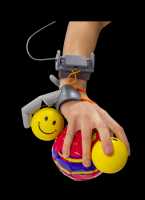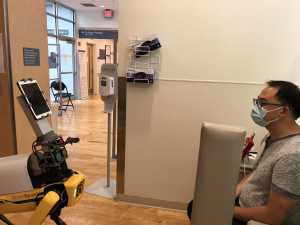Author Interviews, Technology / 28.05.2021
Robotic Third Thumb Quickly Becomes Useful in Everyday Tasks
MedicalResearch.com Interview with:
Dani Clode
Designer & Senior Research Technician
Plasticity Laboratory
Institute of Cognitive Neuroscience
University College London
MedicalResearch.com: What was the inspiration behind creating the Third Thumb?
Response: From a design perspective, augmentation is about designing a new relationship with technology, creating something that is no longer just a tool for the hand, but instead an extension of the hand. I created the Third Thumb during my Design Product Masters project at the Royal College of Art (London). The Third Thumb is a flexible 3D-printed thumb extension for your hand, controlled by your toes. It is operated wirelessly with pressure sensors and affords proportional control over two degrees of freedom. The project began as a way to better understand what it was like to control something extra attached to my body. As an upper-limb prosthetics designer,
I wanted to understand the unique relationship between a person and a prosthetic, it’s a relationship unlike any other product, and I wanted to explore that. The Plasticity Lab then got in contact with me after seeing the Third Thumb online, as they were already exploring augmentation in the brain. We started collaborating on this research shortly after, and I now work as an in-house designer for the Plasticity Lab, collaborating on neuroscience research.
(more…)



 MedicalResearch.com: What is the background for this study? What are some of the functions that Dr. Spot can facilitate?
Response: During the COVID-19 pandemic, we wanted to consider innovative methods to provide additional social distance for physicians evaluating low acuity individuals who may have COVID-19 disease in the emergency department. While other health systems had instituted processes like evaluating patients from outside of emergency department rooms or calling patients to obtain a history, we considered the use of a mobile robotic system in collaboration with Boston Dynamics to provide telemedicine triage on an agile platform that could be navigated around a busy emergency department. Dr. Spot was built with a camera system to help an operator navigate it through an emergency department into a patient room where an on-board tablet would permit face-to-face triage and assessment of individuals.
MedicalResearch.com: What is the background for this study? What are some of the functions that Dr. Spot can facilitate?
Response: During the COVID-19 pandemic, we wanted to consider innovative methods to provide additional social distance for physicians evaluating low acuity individuals who may have COVID-19 disease in the emergency department. While other health systems had instituted processes like evaluating patients from outside of emergency department rooms or calling patients to obtain a history, we considered the use of a mobile robotic system in collaboration with Boston Dynamics to provide telemedicine triage on an agile platform that could be navigated around a busy emergency department. Dr. Spot was built with a camera system to help an operator navigate it through an emergency department into a patient room where an on-board tablet would permit face-to-face triage and assessment of individuals.
